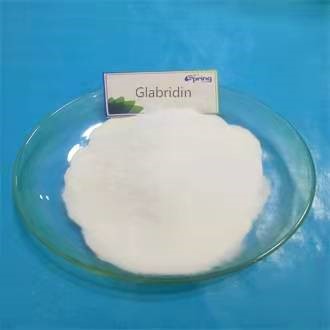It was once known as "whitening gold", and its reputation lies in its incomparable whitening effect on the one hand, and the difficulty and scarcity of its extraction on the other. The plant Glycyrrhiza glabra is the source of Glabridin, but Glabridin only accounts for 0.1%-0.3% of its overall content, that is to say, 1000kg of Glycyrrhiza glabra can only obtain 100g of Glabridin, 1g of Glabridin is equivalent to 1g of physical gold.
Hikarigandine is a typical representative of herbal ingredients, and its whitening effect is discovered by Japan
Glycyrrhiza glabra is a plant of the genus Glycyrrhiza. China is the country with the richest herbal resources in the world, and there are more than 500 kinds of herbs used in clinical practice, among which the most used is licorice. According to statistics, the usage rate of licorice is over 79%.
Due to the long history of application, accompanied by a high reputation, the scope of research on the value of licorice has not only broken through the geographical limits, but also the application has been expanded. According to research, consumers in Asia, especially in Japan, have a great reverence for cosmetics containing herbal active ingredients. 114 herbal cosmetic ingredients have been recorded in "Japan's General Cosmetics Raw Materials", and there are already 200 kinds of cosmetics containing herbal ingredients in Japan.
It is recognized to have super whitening effect, but what are the difficulties in practical application?
The hydrophobic part of licorice extract contains a variety of flavonoids. As the main component of its hydrophobic part, halo-glycyrrhizidine has an inhibitory effect on melanin production and also has anti-inflammatory and anti-oxidant effects.
Some experimental data show that the whitening effect of light Glabridin is 232 times higher than that of ordinary vitamin C, 16 times higher than that of hydroquinone, and 1,164 times higher than that of arbutin. On how to achieve stronger whitening function, light Glabridin gives three different ways.
1. Inhibition of tyrosinase activity
The main whitening mechanism of Glabridin is to inhibit the synthesis of melanin by competitively inhibiting tyrosinase activity, taking away part of tyrosinase from the catalytic ring of melanin synthesis and preventing the binding of substrate to tyrosinase.
2. Antioxidant effect
It can inhibit both the activity of tyrosinase and dopa pigment interchange and the activity of dihydroxyindole carboxylic acid oxidase.
It has been shown that at a concentration of 0.1mg/ml, photoglycyrrhizidine can act on cytochrome P450/NADOH oxidation system and scavenge 67% of free radicals, which has strong antioxidant activity.
3.Inhibit inflammatory factors and fight against UV
Currently, less research has been reported on the use of photoglycyrrhizidine in the study of UV-induced skin photoaging. In 2021, in an article in the core journal Journal of Microbiology and Biotechnology, photoglycyrrhizidine liposomes were studied for their ability to ameliorate UV light-induced erythema and skin disease by inhibiting inflammatory factors. Photoglycyrrhizidine liposomes can be used to improve bioavailability with less cytotoxicity along with better melanin inhibition, effectively reducing the expression of inflammatory cytokines, interleukin 6 and interleukin 10. Therefore, it can be used as a topical therapeutic agent to counteract UV radiation-induced skin damage by inhibiting inflammation, which may provide some ideas for the research of sunlight whitening protection products.
In summary, the whitening effect of photoglycyrrhizidine is recognized, but its own nature is almost insoluble in water, so it is particularly demanding for the production and manufacturing process in the application of skin care product addition, and it is currently a good solution through liposome encapsulation technology. Moreover, photoGlabridin liposomes can prevent UV-induced photoaging, but this function needs more clinical experiments to be confirmed and research applications to be implemented.
Skin care products containing photoGlabridin in the form of ingredient compounding.
While there is no doubt that photoGlabridine has a very good whitening effect, its raw material price is also prohibitive due to the difficulties in extraction and content. In cosmetic R&D, the work of controlling costs is directly linked to the technological content and scientific process. Therefore, it is a good way to control the cost of formulations and to achieve safe and effective quality by selecting the active ingredients and combining them in compounding with photoglycyrrhizidine. In addition at the R&D level, further exploration is needed regarding the research of photoglycyrrhizidine liposomes and the latest extraction techniques.

Post time: Aug-30-2022

